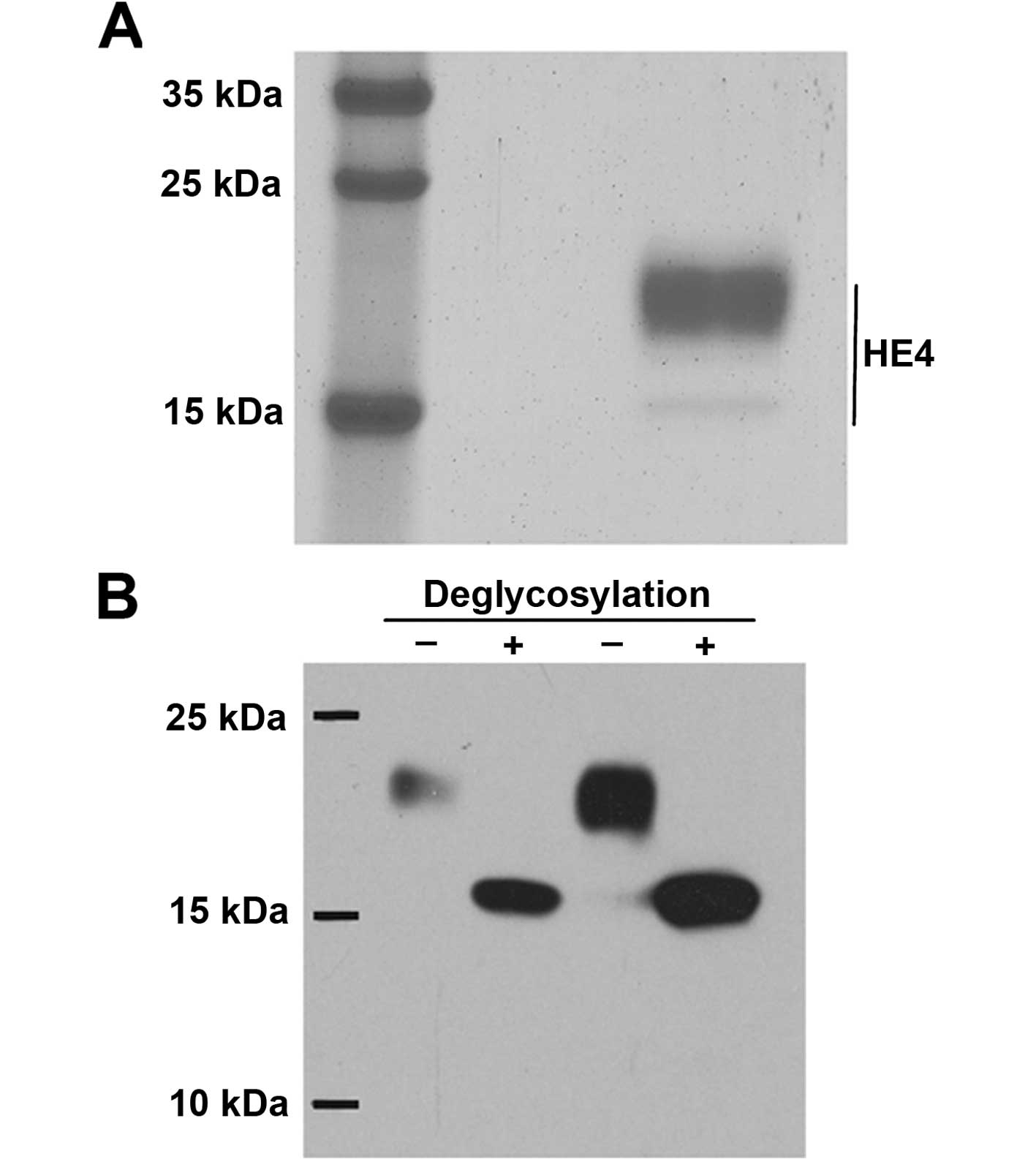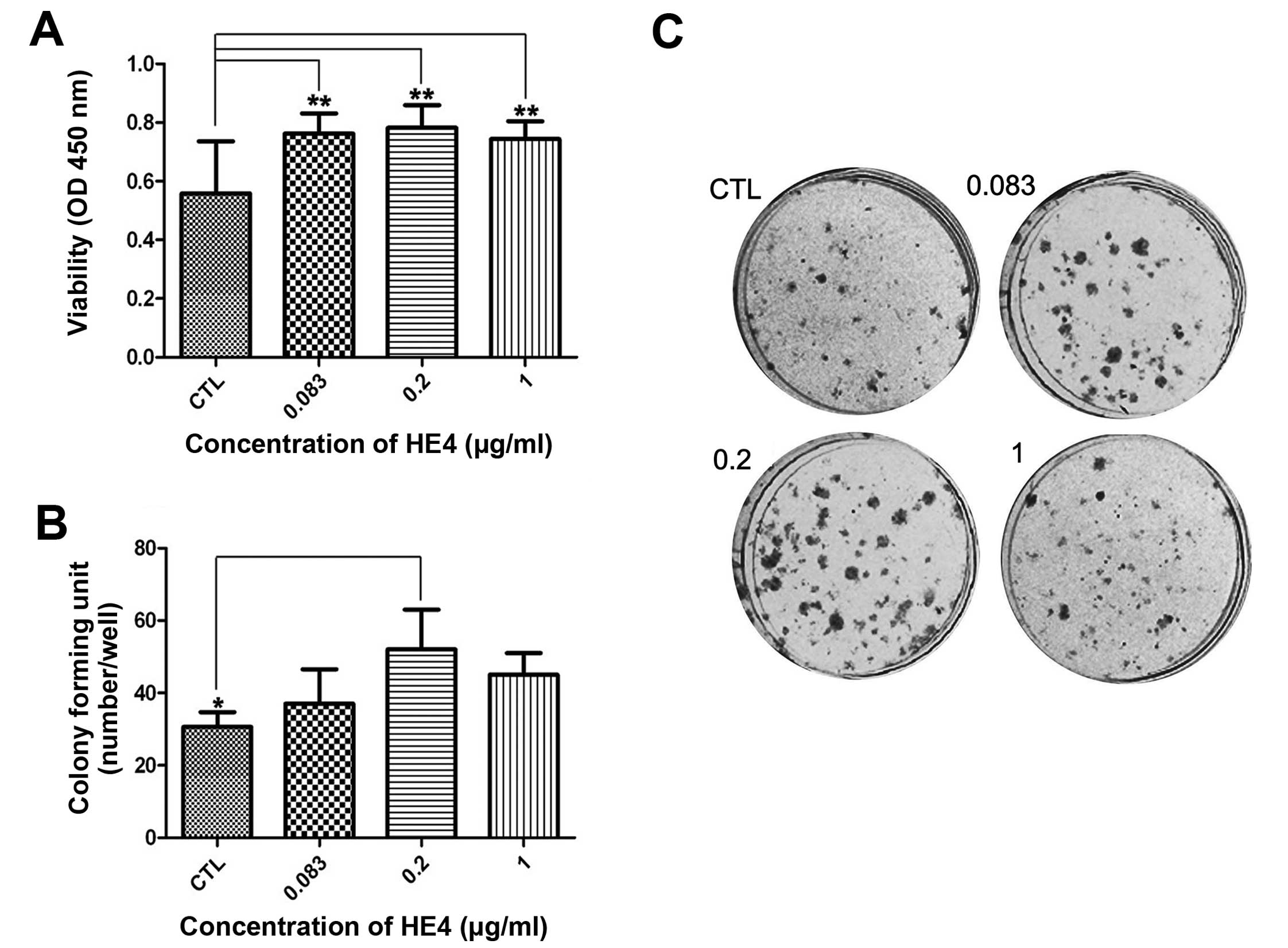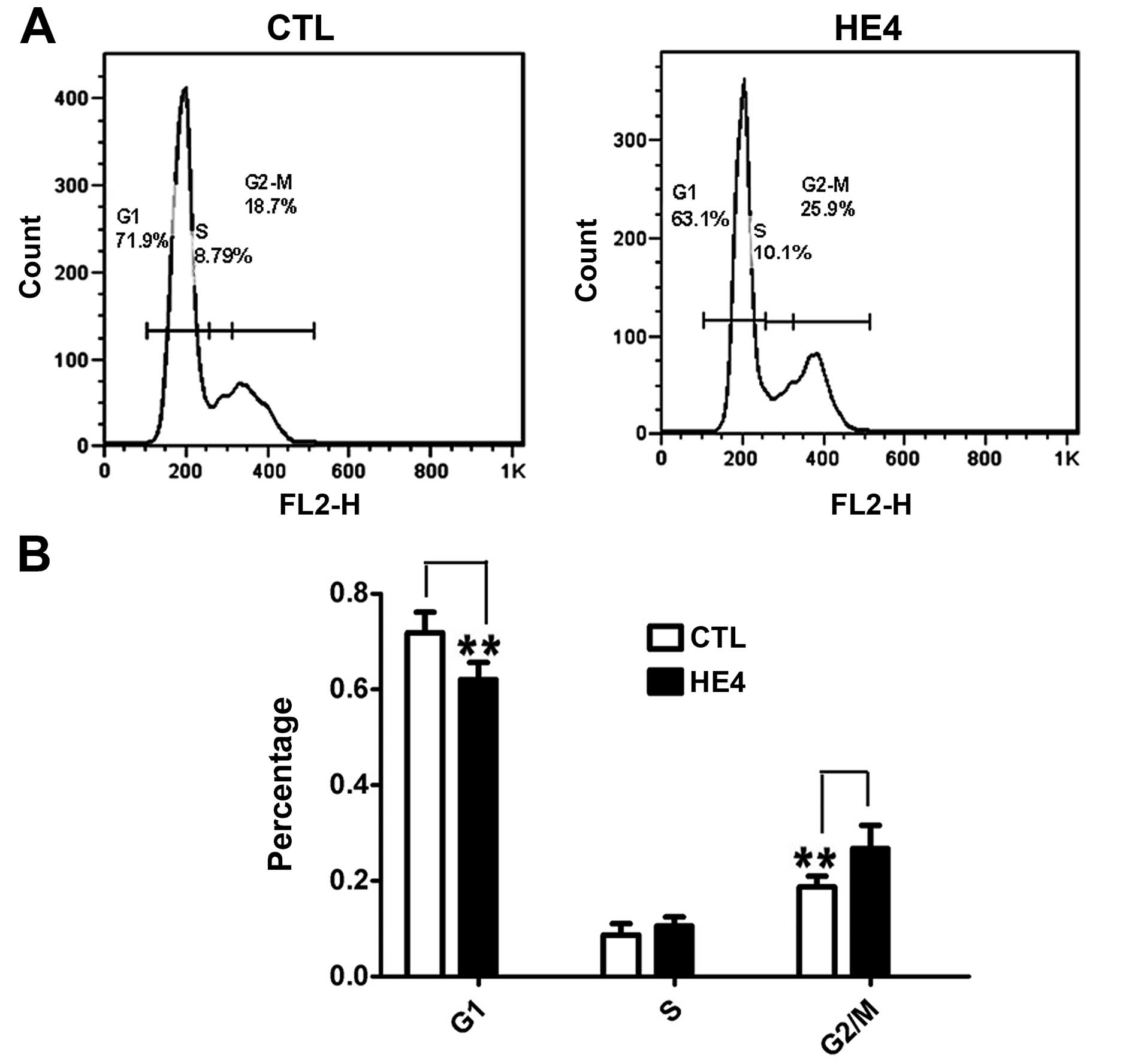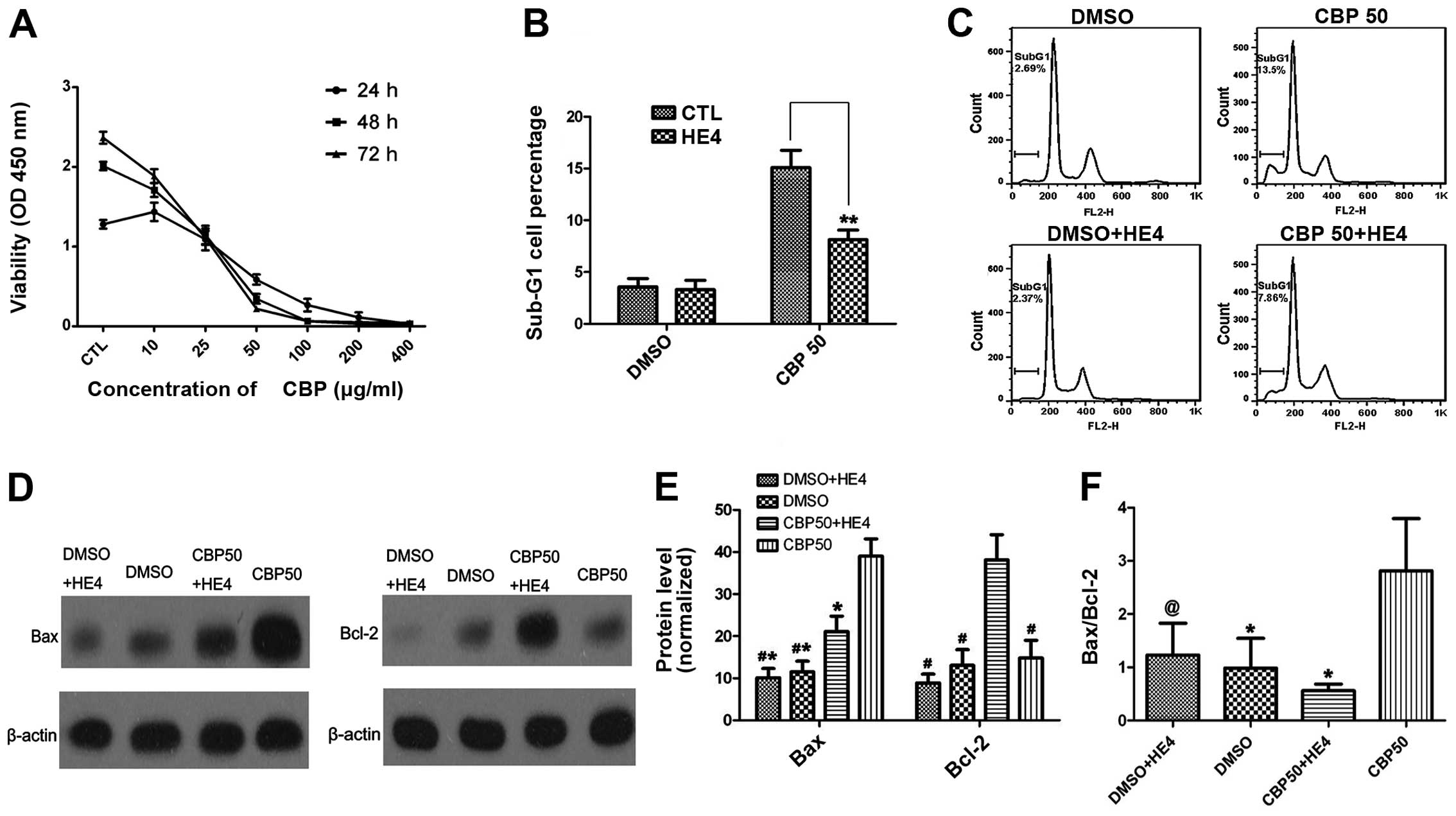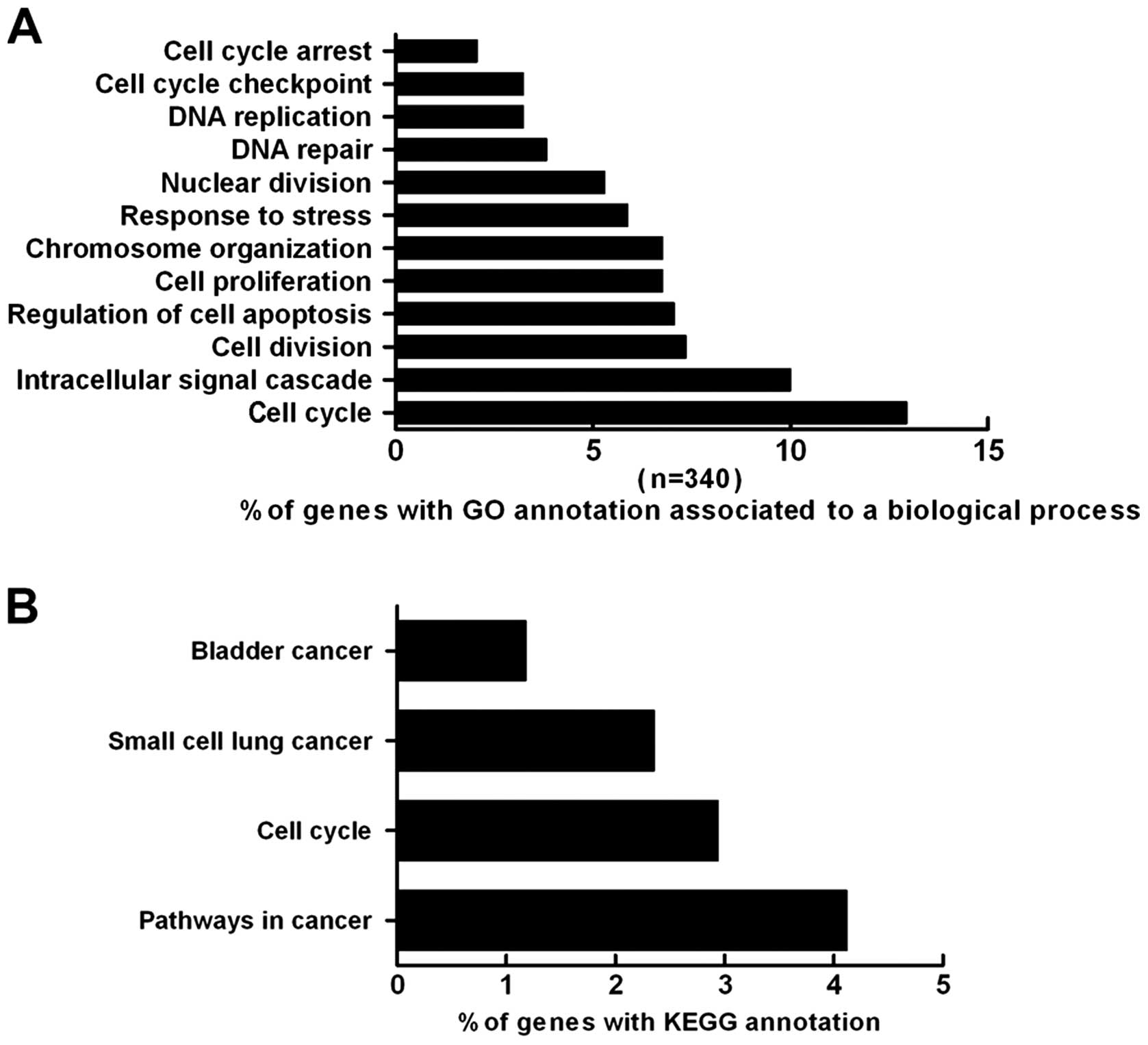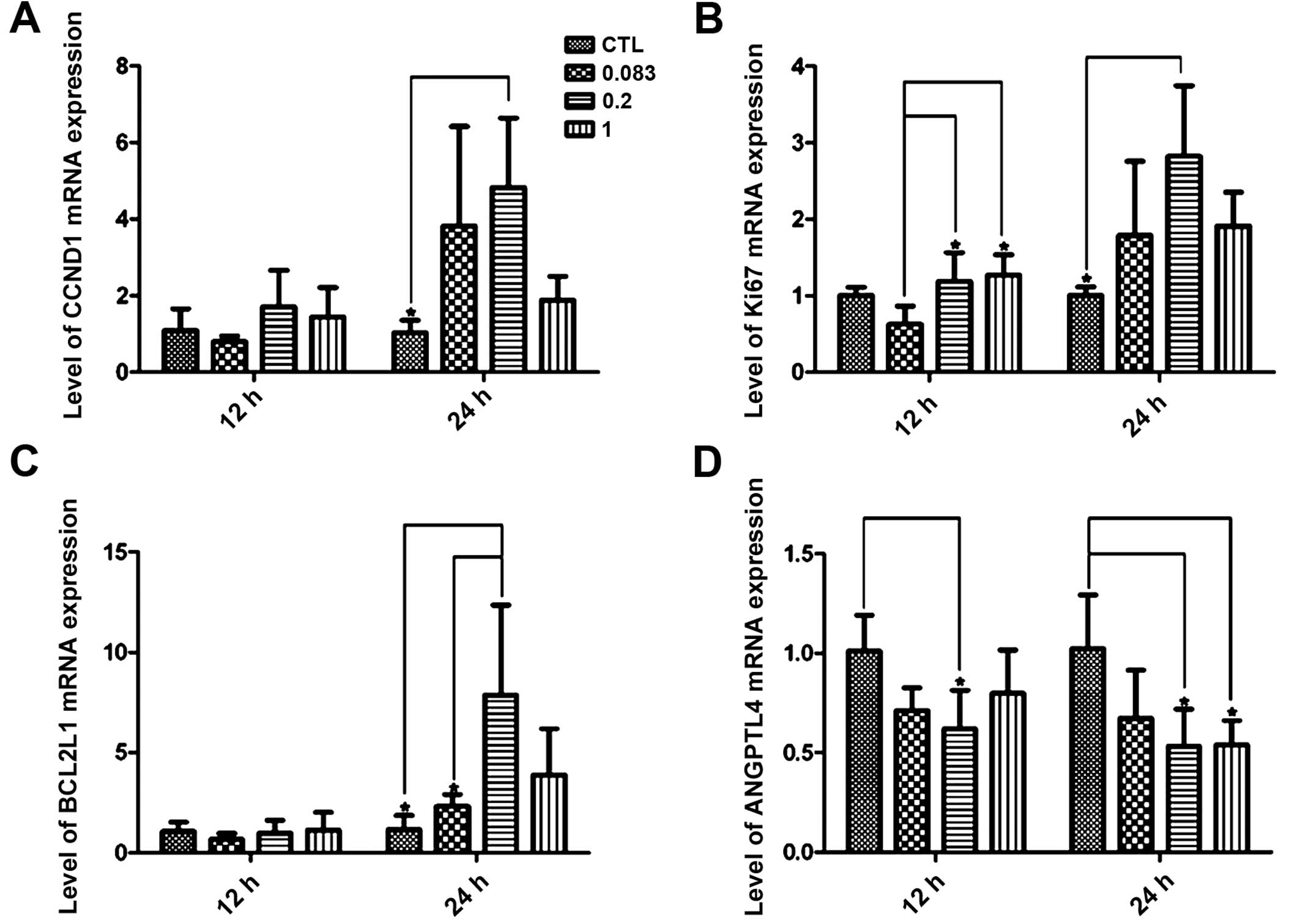Promotive role of recombinant HE4 protein in proliferation and carboplatin resistance in ovarian cancer cells
- Authors:
- Published online on: October 17, 2014 https://doi.org/10.3892/or.2014.3549
- Pages: 403-412
Abstract
Introduction
Epithelial ovarian cancer (EOC) causes the highest rates of mortality among genital tract malignancies in women. It is most often diagnosed at the advanced stage of peritoneal carcinomatosis with a poor prognosis (5-year survival rate 30–35%). Screening and early detection could probably reduce the mortality rate.
HE4 was originally identified in the epithelium of the distal epididymis using northern blot analysis and in situ transcript hybridization in 1991 (1,2). The HE4 gene resides on human chromosome 20q12-13.1, a region that harbors a locus of 14 genes encoding protein domains that have homology with whey acidic protein (WAP) (3). Two functions attributed to this family of proteins are the regulation of proinflammatory mediators and anti-bacterial or anti-fungal activity (4,5). There is a growing body of evidence demonstrating the tumor-promoting roles of WAP domain family members (6,7). Among these WAP genes is secretory leukocyte protease inhibitor (SLPI), which is also overexpressed in ovarian cancer (6,8). Hoskins et al (8) reported that SLPI stimulated ovarian cancer invasion, modulated in part by its serine protease inhibitory activity. Significantly, comparative genomic hybridization studies have shown that 20q13 is among the most frequently amplified chromosomal regions in ovarian cancers (9–11). HE4 contains WAP domains (12). Based on structural and sequence similarities with those from other WAP family members, it was suggested that the protein may exert antiprotease activity. LeBleu et al (13) identified HE4 as a protease inhibitor using mouse models of renal fibrosis disease for the first time.
Expression of the HE4 gene is highly restricted in normal human tissues, being largely limited to the epithelium of the respiratory tracts, oral and reproductive tracts, and HE4 is not expressed in normal ovarian surface epithelium (14,15). HE4 has been reported to be upregulated in several types of cancers including those of the ovary (16), endometrium (17), lung (18,19), breast (7,15), stomach and pancreas (20). The expression of HE4 in ovarian cancer was initially reported in 1999 (16), and it was subsequently cleared as a new biological marker of ovarian cancer in 2003 (21). Since then it has been shown to be potentially useful for remission monitoring (22–24) and has been approved by the US Food and Drug Administration (FDA) for that use. Current studies are focusing on the clinical application of HE4 in EOC as a biomarker, and the diagnostic and predictive value of HE4 in EOC have been confirmed (25,26). Several studies have aimed to establish a role for HE4 in cell proliferation using overexpression and knockdown analyses (27–29), although the results are controversial. Notably, few studies have been carried out on the predictive value of HE4 on platinum resistance and the molecular mechanism of chemoresistance mediated by HE4.
In the present study, we focused on the effects of the recombinant HE4 protein on cell proliferation and carboplatin resistance in SKOV-3 cells, with the aim of providing a theoretical foundation for HE4 to be used as a predictor for tumor growth potential and resistance to platinum-based chemotherapy in EOC.
Materials and methods
Chemicals and reagents
The recombinant HE4 protein, which was expressed and purified in eukaryotic cells, was purchased from Sino Biological, Inc. (Beijing, China; cat. 12609-H08H). Carboplatin and dimethyl sulfoxide (DMSO) were purchased from Sigma (St. Louis, MO, USA). McCoy’s 5A Modified Medium, fetal bovine serum (FBS) and TRIzol reagent were purchased from Invitrogen (Carlsbad, CA, USA). The SYBR-Green PCR Master Mix kit was purchased from Toyobo (Osaka, Japan). The Cell Counting Kit-8 (CCK-8) was purchased from Dojindo (Kumamoto, Japan).
Cell cultures and treatments
The ovarian cancer cell line SKOV-3 was purchased from the Cell Culture Collection of Shanghai (Shanghai, China) and was propagated in McCoy’s 5A Modified Medium with 10% FBS. The cell cultures were maintained in an incubator at 37°C in a humidified atmosphere with 95% air and 5% CO2.
CCK-8 assay
SKOV-3 cells were seeded into 96-well plates (2×103 cells/well) and cultured with serum-free McCoy’s 5A Modified Medium for 24 h. After treatment with the HE4 protein at different concentrations (0.083, 0.2 or 1 μg/ml) or isometric serum-free medium for 48 h, 10 μl of the tetrazolium substrate was added to each well (starting volume of culture media, 100 μl). The plates were incubated at 37°C for 2 h, and a microplate reader was used to determine the absorbance of each group at 450 nm. For each group, three wells were used to calculate the average absorbance value. Finally, curves or column graphs were drawn to compare the cell proliferation between the groups.
SKOV-3 cells were seeded into 96-well plates (5×103 cells/well) and cultured in McCoy’s 5A Modified Medium with 10% FBS for 48 h. After exposure to carboplatin (10, 25, 50, 100, 200 and 400 μg/ml) or isometric DMSO for different duration (24, 48 and 72 h), 10 μl of the tetrazolium substrate was added to each well (starting volume of culture media, 100 μl). The plates were incubated at 37°C for 2 h, and a microplate reader was used to determine the absorbance of each group at 450 nm. For each group, 3 wells were used to calculate the average absorbance value. The growth inhibitory rate and the IC50 value were evaluated using SPSS statistical software (version 17.0) (SPSS, Inc., Chicago, IL, USA).
Colony formation assay
SKOV-3 cells were seeded into 6-well plates (1×103 cells/well) and were cultured in serum-free medium that contained the recombinant HE4 protein at different concentrations (0.083, 0.2 and 1 μg/ml) or isometric serum-free medium. After 2 days, the cells were cultured in medium with 10% FBS and the HE4 protein at the concentrations mentioned above; the medium was replaced every 2 days. Two weeks later, the total number of colonies in each plate was determined and analyzed using ImageJ software (National Institutes of Health, Bethesda, MD, USA) version 1.31v. Each experiment was repeated three times for each group, and the results were subjected to statistical analysis.
Flow cytometry (FCM) for analysis of the cell cycle
SKOV-3 cells were seeded into 6-well plates (12×104 cells/well) and were cultured in McCoy’s 5A Modified Medium with 0.5% FBS for 24 h. After treatment with the recombinant HE4 protein (0.2 μg/ml) or isometric serum-free medium for 24 h, the cells were collected and fixed with 2 ml of 70% ethanol at 4°C for 2 h. Then, the cells were washed with 1× phosphate-buffered solution (PBS) and incubated for 15 min at room temperature in 1× PBS containing 100 μg/ml RNase A and 50 μg/ml propidium iodide (PI). DNA content and cell cycle analyses were performed using FACScan (Becton-Dickinson, Franklin Lakes, NJ, USA). Each experiment was repeated three times for each group, and the results were subjected to statistical analysis.
FCM for analysis of apoptosis
SKOV-3 cells were plated into 6-well plates (15×104 cells/well) and were cultured in McCoy’s 5A Modified Medium with 0.5% FBS for 24 h. After being incubated with the recombinant HE4 protein (0.2 μg/ml) or isometric serum-free medium for 24 h, the cells were treated with carboplatin (50 μg/ml) or isometric DMSO for 24 h. The cells were then collected, fixed and washed with 1× PBS and were incubated for 15 min at room temperature in 1× PBS containing 100 μg/ml RNase A and 50 μg/ml PI. DNA content and cell cycle analyses were performed using FACScan. Based on PI staining, the hypodiploid peak (sub-G1 peak) on the DNA histogram was considered to be an indicator of apoptosis. We therefore quantified the sub-G1 peak area. Each experiment was repeated three times for each group, and the results were subjected to statistical analysis.
Western blotting
The SKOV-3 cells were prepared as previously described in apoptosis assay. Briefly, cells were seeded into 6-well plates (15×104 cells/well) and were cultured in McCoy’s 5A Modified Medium with 0.5% FBS for 24 h. After being treated with the HE4 protein (0.2 μg/ml) or isometric serum-free medium for 24 h, carboplatin (50 μg/ml) or isometric DMSO was added, respectively. The cells were harvested at 48 h post-treatment. Proteins were separated by SDS-PAGE and transferred to nitrocellulose membranes. Expression of the target proteins was determined using the following primary antibodies: Bax (1:200) and Bcl-2 (1:200) (both from Cell Signaling Technology, USA). The protein expression levels were visualized using the enhanced chemiluminescence method. The intensity of each protein band was quantified using ImageJ 1.31v and normalized relative to the actin protein expression level.
Microarray profiling and data analysis
For microarray analysis, the SKOV-3 cell samples were treated with the recombinant HE4 protein (0.2 μg/ml) or isometric serum-free medium after starvation. At 12 h post-treatment, the cells were rinsed once with ice-cold PBS and lysed, and total RNA was isolated using TRIzol reagent. The two samples were sent to Gene Tech, Ltd. (Shanghai, China) for microarray hybridization and detection. We used the PrimeView Human Gene Expression Array, which covers >36,000 transcripts, variants and expressed sequence tags. All the samples were normalized and summarized using the robust multichip analysis (RMA) normalization method, which includes background correction, normalization and calculation of the expression values. The data analysis was performed using Partek Genomics Suite 6.6 software. Genes were filtered on the basis of call, fold-change and P-value. All genes with a signal more than ±1.5-fold and P-value <0.05 were chosen to be statistically altered by HE4. A Gene Ontology (GO) term enrichment analysis was performed using DAVID version 6.7 (http://david.abcc.ncifcrf.gov/). The Kyoto Encyclopedia of Genes and Genomes (KEGG) was used to identify the biological pathways in which the differentially expressed genes are involved.
Real-time quantitative polymerase chain reaction
Template cDNA was synthesized from total RNA that was isolated from the SKOV-3 cell samples. All the PCR reactions were performed using the SYBR-Green PCR Master Mix kit. Briefly, each PCR reaction contained 1× Master Mix, 1 μl of the diluted cDNA, and 250 nM forward and reverse primers. PCR was performed over 40 cycles (95°C for 20 sec and 60°C for 30 sec) following an initial 3-min enzyme activation step at 95°C. The primers that were used in the present study for PCR validation are listed in Table I. Each experiment was repeated three times for each group, and β2-microglobulin (β2-MG) was used as an endogenous control (reference) gene.
Statistical analysis
SPSS version 17.0 (SPSS, Inc., Chicago, IL, USA) software was used for the statistical analysis. The data are expressed as means ± standard deviation (SD). The statistical significance of the differences between the groups was evaluated using one-way analysis of variance (ANOVA), followed by a least significant difference (LSD) test. P<0.05 was considered to indicate a statistically significant result.
Results
Validation of the recombinant protein product
The recombinant HE4 protein product was validated before the experiments were initiated. SDS-PAGE, stained with Coomassie blue dye, revealed that the molecular mass was ~20 kDa (Fig. 1A), which was consistent with previous reports (13). Next, glycation modification was tested, and the recombinant protein was treated with a deglycosylation enzyme (PNGase), which indicated that the migration of the protein was concentrated at the 15-kDa position on SDS-PAGE (Fig. 1B). Therefore, the protein could be expressed and could undergo glycosylation modification, which is consistent with the characteristics of HE4 as a glycoprotein. We further confirmed that the recombinant protein was HE4, according to protein mass spectrometry (data not shown).
According to the manufacturer’s instructions, the initial concentration of the recombinant HE4 protein was 250 μg/ml. Based on several in vitro trials involving recombinant proteins (30) and the results of preliminary experiments, the HE4 original solution was diluted 250-fold (1 μg/ml), 1,250-fold (0.2 μg/ml) and 3,000-fold (0.083 μg/ml), respectively, for follow-up experiments.
Recombinant HE4 protein stimulates cell proliferation
Uncontrolled proliferation is a feature of malignant cancer that potentially contributes to cancer progression. To ascertain the effects of the recombinant HE4 protein on cell proliferation, we performed a CCK-8 assay using SKOV-3 cells. As shown in Fig. 2A, compared with the control cells, the HE4-treated cells exhibited enhanced viability at 48 h. It is notable that the highest viability level was found in cells exposed to 0.2 μg/ml HE4 protein (P<0.01).
Next, we carried out colony formation assays. As shown in Fig. 2B and C, adding the recombinant HE4 protein (0.2 μg/ml) to SKOV-3 cells resulted in the formation of significantly more colonies compared with the control cells (P<0.05).
These results indicated that the HE4 protein promoted the proliferation of SKOV-3 cells, and the optimal concentration of HE4 protein used in the CCK-8 and colony formation assays was 0.2 μg/ml.
Recombinant HE4 protein promotes cell cycle progression
We examined the effects of HE4 on cell cycle distribution using SKOV-3 cells. DNA content and cell cycle distribution were determined by FCM. As shown in Fig. 3A and B, a significantly increased number of cells in the G2/M phase (P<0.01) and a decreased number of cells in the G0/G1 phase (P<0.01) were observed in the HE4 protein-treated group. This result confirmed that the HE4 protein promotes cell cycle progression.
Recombinant HE4 protein represses carboplatin-induced apoptosis
We firstly performed a cell proliferation assay to determine the viability of cells exposed to carboplatin (0–400 μg/ml) and the growth inhibitory effects of carboplatin on SKOV-3 cells were evaluated. As shown in Fig. 4A, the SKOV-3 cells were relatively sensitive to carboplatin. Based on an analysis of the cell growth inhibition rate performed using SPSS statistical software (version 17.0), the IC50 value was 27.6±1.053 μg/ml.
Next, we tested whether the HE4 protein could attenuate carboplatin-induced apoptosis. Considering that HE4 may mediate the protective effect against apoptosis, we performed preliminary experiments for analysis of apoptosis with different concentrations of carboplatin (30 and 50 μg/ml) combined with HE4 (0, 0.2 μg/ml), and the optimal concentration of carboplatin was determined to be 50 μg/ml (data not shown). In follow-up experiments, SKOV-3 cells were treated with the combination of carboplatin (50 μg/ml) with HE4 protein (0.2 μg/ml) or with carboplatin alone (50 μg/ml). As shown in Fig. 4B and C, the percentage of cells in the sub-G1 phase was decreased in the group treated with carboplatin combined with HE4, compared with the group treated with carboplatin alone (P<0.01), indicating that the HE4 protein attenuated carboplatin-induced apoptosis.
We further assessed markers of apoptosis (Bax and Bcl-2) by western blotting in order to confirm the role of HE4 in apoptosis (Fig. 4D and E). Our results indicated that the expression of the anti-apoptotic protein Bcl-2 was markedly increased in the group treated with carboplatin combined with HE4, compared with the group treated with carboplatin alone (P<0.01). In contrast to Bcl-2, the expression of the pro-apoptotic protein Bax was markedly reduced in the combination-treatment group compared with the group treated with carboplatin alone (P<0.01). HE4 markedly decreased the Bax/Bcl-2 ratio (P<0.01) (Fig. 4F).
Gene expression profile of the SKOV-3 cell line
To identify genes altered by HE4 in SKOV-3 cells, mRNA expression in these cells incubated in the absence and presence of HE4 protein (0.2 μg/ml, 12 h) was analyzed using PrimeView Human Gene Expression Array. The HE4 treatment significantly (P<0.05) altered the expression of 387 genes in the SKOV-3 cells (236 upregulated and 151 downregulated) (Table II).
Table IIOverview of the relevant differentially expressed genes following treatment with recombinant HE4 protein (0.2 μg/ml) using microarray analyses. |
Identification and analysis of differentially expressed genes
The GO project is an international system of classification in which the major biological processes, cellular components or molecular functions of genes and their products are described using a controlled vocabulary GO terms (31). The GO annotation of our data set indicated that the differentially expressed genes in the SKOV-3 cells after treatment with HE4 were involved in many processes, such as cell cycle regulation (12.9%), signal transduction (10%), cell proliferation (6.8%), apoptosis (7.1%), DNA repair (3.8%) and the stress response (5.9%) (Fig. 5A).
The KEGG database was utilized to determine the associations between genes and pathways. The present analysis revealed that the genes altered by HE4 are involved in several pathways. Overall, 4.12% of the genes are involved in cancer pathways, and 2.94% of the genes are associated with the cell cycle. Additionally, 1.18 and 2.35% of the genes are associated with bladder cancer and small-cell lung cancer pathways, respectively (Fig. 5B).
Quantitative real-time PCR validation
We next determined the differential expression of four genes, CCND1, KI67, BCL2L1 and ANGPTL4, using quantitative real-time PCR with independent RNA samples to confirm the validity of the microarray results. In the majority of the samples, the results were significantly correlated with the microarray data (Table II and Fig. 6), and it was notable that the relatively low concentrations of HE4 (0.2 μg/ml) significantly altered the mRNA expression of all the four genes at the 24 h time point (P<0.05).
Discussion
An increasing number of investigations validate the diagnostic and predictive value of HE4 in EOC. A previous study by our group (32) showed that the HE4-positive staining was found more frequently in the epithelium of serous ovarian carcinomas, compared with borderline and benign tumors by immunohistochemical methods, and a positive correlation between expression of HE4 protein and clinical stage was suggested. It is being accepted recently that HE4 may play a critical role in promoting the malignancy of ovarian cancer cells as well. Lu et al (33) showed that proliferation was significantly inhibited in a SKOV-3 stable strain with silenced HE4, suggested that HE4 enhanced proliferation by activating the EGFR-MAPK pathway. Moore et al (27) showed that HE4 overexpression promoted xenograft tumor growth in a mouse model for ovarian cancer. However, other reports have presented opposing views. Gao et al (28) reported that the upregulation of HE4 led to the significantly reduction in the number of colonies in ovarian cancer cell lines SKOV-3 and ES-2. Kong et al (29) suggested that HE4 protein plays a protective role in SKOV-3 cells by inhibiting cell proliferation. The present study indicated that recombinant HE4 protein enhanced cell viability and promoted accumulation of cells in the G2/M phase. The findings confirm the proliferation-promoting activity of HE4. Contrary to results obtained in our cell model, Kong et al (29) showed that neither conditioned medium containing HE4 nor recombinant HE4 protein had an effect on proliferation in SKOV-3 cells. It should be noted that our research team performed serum starvation on cells 24 h before the HE4 treatment. Serum starvation is accepted as a method to synchronize cells, and it can help to reduce errors among different groups to some extent.
Apart from differential diagnosis and prediction of recurrence and overall survival in EOC (25,26), application of HE4 for other purposes such as a predictor of platinum resistance has not been extensively investigated. Angioli et al (25) suggested that evaluating the serum HE4 values during first-line chemotherapy could predict chemotherapy response in EOC patients. Hynninen et al (34) showed that assessment of serum HE4 could improve the reliability of response evaluation during chemotherapy for serous EOC compared with CA125. To date, there have been few studies on the role of HE4 in enhancing the resistance to drug chemotherapy in ovarian cancer cells. Moore et al (27) showed that HE4 overexpression induced resistance to cisplatin in a mouse model for ovarian cancer. Previous experiments conducted in our laboratory showed that the expression of HE4 antigen was significantly higher in the drug-resistant group, and the expression of HE4 and the pathological stage were both independent risk factors for drug resistance in EOC (unpublished data). In the present study, we showed that HE4 could attenuate apoptosis induced by carboplatin through decreasing the mitochondrial Bax/Bcl-2 ratio; as HE4 markedly increased Bcl-2 expression while inhibiting Bax expression. This finding provides new insight into the role of HE4 in carboplatin resistance in ovarian cancer cells.
Microarray analysis of SKOV-3 genes altered by HE4 identified 236 genes as upregulated and 151 genes as downregulated. The significantly and consistently upregulated genes were genes involved in cell cycle regulation and proliferation mainly MTOR, CCND1, KIT and KI67, thus indicating cell proliferation to be crucially targeted by HE4 protein. This suitably agrees with our findings that HE4 protein is very significant in promoting the proliferation of ovarian cancer cells. Among those within the downregulated dataset include genes involved in several aspects of the DNA damage response such as positive regulation of apoptosis, ATM and BNIP3. This result is consistent with our finding that HE4 protein attenuated carboplatin-induced apoptosis.
We also performed quantitative real-time PCR to analyze the expression of four genes, CCND1, KI67, BCL2L1 and ANGPTL4, to confirm the validity of the microarray results and the results were significantly correlated with the microarray data. We observed that after 24 h, the mRNA expression of all four genes was significantly altered in the cells treated with a relatively low concentration of the HE4 protein (0.2 μg/ml), and the concentration was consistent with the optimal concentration in the CCK-8 and colony formation assays. We chose these four genes since the expression of their mRNA differed clearly from those of the control group and they were related to cell cycle regulation, proliferation and apoptosis based on Gene Ontology (GO) terms. It is important that the elevated expression of BCL2L1 (also known as Bcl-xL), an essential anti-apoptotic regulator, was confirmed by quantitative real-time PCR. We also demonstrated that HE4 protein regulated the expression of the Bcl-2 family members Bax and Bcl-2 using western blotting. We speculate that regulation of Bcl-2 family members is a downstream event that occurs after HE4 treatment in SKOV-3 cells. Further biological experiments are required to elucidate the exact roles of HE4 in attenuating carboplatin-induced apoptosis. Unfortunately, the current analysis did not reveal any information concerning signaling pathways such as EGFR-MAPK, which were reported in recent articles on HE4 (29,33). We hypothesize that HE4 may initiate signaling within the cell by binding to a receptor protein, altering the mRNA levels of critical target genes associated with cell proliferation and apoptosis; and then inducing biological effects, including enhanced proliferation and resistance to apoptosis induced by carboplatin. Additional research is needed to confirm this hypothesis.
In summary, the present study indicated that the HE4 protein played a promotive role in the proliferation and resistance to carboplatin-induced apoptosis in the ovarian cancer cell line SKOV-3. An analysis of the function and regulation of the candidate genes screened by microarray will help to determine underlying signaling pathways and target genes coordinated in the cellular response to HE4. Our findings also provide a theoretical foundation for HE4 to be used as a predictor for tumor growth potential and resistance to platinum-based chemotherapy in EOC.
Acknowledgements
This study was supported by the National Natural Science Foundation of China (nos. 81172491 and 81101527), the Ph.D. Programs Foundation of Ministry of Education of China (nos. 20112104110016 and 20112104120019), and the Shengjing Free Researcher Project (no. 201303).
References
|
Kirchhoff C, Habben I, Ivell R and Krull N: A major human epididymis-specific cDNA encodes a protein with sequence homology to extracellular proteinase inhibitors. Biol Reprod. 45:350–357. 1991. View Article : Google Scholar : PubMed/NCBI | |
|
Kirchhoff C: Molecular characterization of epididymal proteins. Rev Reprod. 3:86–95. 1998. View Article : Google Scholar : PubMed/NCBI | |
|
Clauss A, Lilja H and Lundwall A: A locus on human chromosome 20 contains several genes expressing protease inhibitor domains with homology to whey acidic protein. Biochem J. 368:233–242. 2002. View Article : Google Scholar : PubMed/NCBI | |
|
Williams SE, Brown TI, Roghanian A and Sallenave JM: SLPI and elafin: one glove, many fingers. Clin Sci. 110:21–35. 2006. View Article : Google Scholar | |
|
Moreau T, Baranger K, Dadé S, Dallet-Choisy S, Guyot N and Zani ML: Multifaceted roles of human elafin and secretory leukocyte proteinase inhibitor (SLPI), two serine protease inhibitors of the chelonianin family. Biochimie. 90:284–295. 2008. View Article : Google Scholar | |
|
Tanner MM, Grenman S, Koul A, et al: Frequent amplification of chromosomal region 20q12-q13 in ovarian cancer. Clin Cancer Res. 6:1833–1839. 2000.PubMed/NCBI | |
|
Larramendy ML, Lushnikova T, Björkqvist AM, et al: Comparative genomic hybridization reveals complex genetic changes in primary breast cancer tumors and their cell lines. Cancer Genet Cytogenet. 119:132–138. 2000. View Article : Google Scholar : PubMed/NCBI | |
|
Hoskins E, Rodriguez-Canales J, Hewitt SM, et al: Paracrine SLPI secretion upregulates MMP-9 transcription and secretion in ovarian cancer cells. Gynecol Oncol. 122:656–662. 2011. View Article : Google Scholar : PubMed/NCBI | |
|
Sonoda G, Palazzo J, du Manoir S, et al: Comparative genomic hybridization detects frequent overrepresentation of chromosomal material from 3q26, 8q24, and 20q13 in human ovarian carcinomas. Genes Chromosomes Cancer. 20:320–328. 1997. View Article : Google Scholar : PubMed/NCBI | |
|
Kiechle M, Jacobsen A, Schwarz-Boeger U, Hedderich J, Pfisterer J and Arnold N: Comparative genomic hybridization detects genetic imbalances in primary ovarian carcinomas as correlated with grade of differentiation. Cancer. 91:534–540. 2001. View Article : Google Scholar : PubMed/NCBI | |
|
Iwabuchi H, Sakamoto M, Sakunaga H, et al: Genetic analysis of benign, low-grade, and high-grade ovarian tumors. Cancer Res. 55:6172–6180. 1995.PubMed/NCBI | |
|
Idoji Y, Watanabe Y, Yamashita A, et al: In silico study of whey-acidic-protein domain containing oral protease inhibitors. Int J Mol Med. 21:461–468. 2008.PubMed/NCBI | |
|
LeBleu VS, Teng Y, O’Connell JT, et al: Identification of human epididymis protein-4 as a fibroblast-derived mediator of fibrosis. Nat Med. 19:227–231. 2013. View Article : Google Scholar : PubMed/NCBI | |
|
Drapkin R, von Horsten HH, Lin Y, et al: Human epididymis protein 4 (HE4) is a secreted glycoprotein that is overexpressed by serous and endometrioid ovarian carcinomas. Cancer Res. 65:2162–2169. 2005. View Article : Google Scholar : PubMed/NCBI | |
|
Galgano MT, Hampton GM and Frierson HF Jr: Comprehensive analysis of HE4 expression in normal and malignant human tissues. Mod Pathol. 19:847–853. 2006.PubMed/NCBI | |
|
Schummer M, Ng WV, Bumgarner RE, et al: Comparative hybridization of an array of 21,500 ovarian cDNAs for the discovery of genes overexpressed in ovarian carcinomas. Gene. 238:375–385. 1999. View Article : Google Scholar : PubMed/NCBI | |
|
Zanotti L, Bignotti E, Calza S, et al: Human epididymis protein 4 as a serum marker for diagnosis of endometrial carcinoma and prediction of clinical outcome. Clin Chem Lab Med. 50:2189–2198. 2012. View Article : Google Scholar : PubMed/NCBI | |
|
Tokuishi K, Yamashita S, Ohbo K and Kawahara K: Splice variant HE4-V3 expression is associated with favorable prognosis in pulmonary adenocarcinoma. Tumour Biol. 33:103–109. 2012. View Article : Google Scholar | |
|
Iwahori K, Suzuki H, Kishi Y, et al: Serum HE4 as a diagnostic and prognostic marker for lung cancer. Tumour Biol. 33:1141–1149. 2012. View Article : Google Scholar : PubMed/NCBI | |
|
O’Neal RL, Nam KT, LaFleur BJ, et al: Human epididymis protein 4 is up-regulated in gastric and pancreatic adenocarcinomas. Hum Pathol. 44:734–742. 2013. View Article : Google Scholar | |
|
Urban N, Thorpe J, Karlan BY, et al: Interpretation of single and serial measures of HE4 and CA125 in asymptomatic women at high risk for ovarian cancer. Cancer Epidemiol Biomarkers Prev. 21:2087–2094. 2012. View Article : Google Scholar : PubMed/NCBI | |
|
Havrilesky LJ, Whitehead CM, Rubatt JM, et al: Evaluation of biomarker panels for early stage ovarian cancer detection and monitoring for disease recurrence. Gynecol Oncol. 110:374–382. 2008. View Article : Google Scholar : PubMed/NCBI | |
|
Anastasi E, Marchei GG, Viggiani V, Gennarini G, Frati L and Reale MG: HE4: a new potential early biomarker for the recurrence of ovarian cancer. Tumour Biol. 31:113–119. 2010. View Article : Google Scholar : PubMed/NCBI | |
|
Schummer M, Drescher C, Forrest R, et al: Evaluation of ovarian cancer remission markers HE4, MMP7 and Mesothelin by comparison to the established marker CA125. Gynecol Oncol. 125:65–69. 2012. View Article : Google Scholar : | |
|
Angioli R, Capriglione S, Aloisi A, et al: Can HE4 predict platinum response during first-line chemotherapy in ovarian cancer? Tumour Biol. 35:7009–7015. 2014. View Article : Google Scholar : PubMed/NCBI | |
|
Braicu EI, Chekerov R, Richter R, et al: HE4 expression in plasma correlates with surgical outcome and overall survival in patients with first ovarian cancer relapse. Ann Surg Oncol. 21:955–962. 2014. View Article : Google Scholar | |
|
Moore RG, Hill EK, Horan T, et al: HE4 (WFDC2) gene over-expression promotes ovarian tumor growth. Sci Rep. 4:35742014. View Article : Google Scholar | |
|
Gao L, Cheng HY, Dong L, et al: The role of HE4 in ovarian cancer: inhibiting tumour cell proliferation and metastasis. J Int Med Res. 39:1645–1660. 2011. View Article : Google Scholar : PubMed/NCBI | |
|
Kong X, Chang X, Cheng H, Ma R, Ye X and Cui H: Human epididymis protein 4 inhibits proliferation of human ovarian cancer cells via the mitogen-activated protein kinase and phosphoinositide 3-kinase/AKT pathways. Int J Gynecol Cancer. 24:427–436. 2014. View Article : Google Scholar : PubMed/NCBI | |
|
Xiao Q, Qu K, Wang C, et al: HDGF-related protein-3 is required for anchorage independent survival and chemoresistance in hepatocellular carcinomas. Gut. 62:440–451. 2013. View Article : Google Scholar | |
|
Camon E, Magrane M, Barrell D, et al: The Gene Ontology Annotation (GOA) Database: sharing knowledge in Uniprot with Gene Ontology. Nucleic Acids Res. 32:D262–D266. 2004. View Article : Google Scholar : | |
|
Zhuang H, Gao J, Hu Z, Liu J, Liu D and Lin B: Co-expression of Lewis y antigen with human epididymis protein 4 in ovarian epithelial carcinoma. PLoS One. 8:e689942013. View Article : Google Scholar : PubMed/NCBI | |
|
Lu R, Sun X, Xiao R, Zhou L, Gao X and Guo L: Human epididymis protein 4 (HE4) plays a key role in ovarian cancer cell adhesion and motility. Biochem Biophys Res Commun. 419:274–280. 2012. View Article : Google Scholar : PubMed/NCBI | |
|
Hynninen J, Auranen A, Dean K, Lavonius M, Carpen O, Perheentupa A, Seppänen M and Grénman S: Serum HE4 profile during primary chemotherapy of epithelial ovarian cancer. Int J Gynecol Cancer. 21:1573–1578. 2011. View Article : Google Scholar : PubMed/NCBI |



